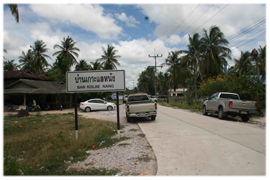The uncertain future of Ban Kolae Nang?
 The name of the village, Ban Kolae Nang, does not ring a bell to most people outside Thepa district of Songkhla. Populated mostly by Thai-Malay ethnic people, the village earned instant notoriety and attracted the attention of security officials when a large band of militants attacked an army development unit based in the village, killing two officials and wounding another on the night of August 24.
The name of the village, Ban Kolae Nang, does not ring a bell to most people outside Thepa district of Songkhla. Populated mostly by Thai-Malay ethnic people, the village earned instant notoriety and attracted the attention of security officials when a large band of militants attacked an army development unit based in the village, killing two officials and wounding another on the night of August 24.
A big question mark was immediately raised among security officials: “What happened to the village which was declared a safe zone?” Officials were so confident of the safety in the village that a group of reporters was invited to make an inspection trip late last year.
Of course, Ban Kolae Nang was believed to be safe haven for Islamic militants. A training camp was believed to be secretly set up in the village to train new recruits. But that was before the army moved in and a development unit was set up to provide occupational training to the villagers in order to lure them back from the militants. As a result, many of the residents turned to crab and cockle farming to make a living.
But since the incident on August 24, the belief that Ban Kolae Nang is a peaceful village has been shattered.
Ban Kolae Nang is one out of eight villages in Thepa district. It can be reached by a single road about 2.5 kilometre from the main Hat Yai-Pattani highway. Most of the terrain is flat and the village looks like an island with one side faces the Gulf of Thailand and the rest surrounded by mangrove forests. There are about 100 households in the village.
Several months before the violent incident, reporters from the Isra news agency had a chance to visit the village and to spend an overnight there. The following is their impression of the village:
“There was an atmosphere of mistrust which could be felt. It appeared that wherever we went, there were someone watching and following us that we could not take a picture of the village although no one told us not to do so. The only place that we felt a bit relaxed was at a crab farm of the officials which was separated from the other farms owned by the villagers.
“There were several elderly people in the village. It was very old and was said to be the home of several court people of  the late sultan of Pattani state,” said an 80-year old grandma. She recalled that several people here used to speak in court language although it is no longer the case now.
the late sultan of Pattani state,” said an 80-year old grandma. She recalled that several people here used to speak in court language although it is no longer the case now.
She went on saying that most villagers in the village made a living by fishing in the Gulf and they pursued suffiency economy. But when it is monsoon season, they turn to growing maize and water melon to make a living, she added.
Ban Kolae Nang also has a history as far as the Second World War is concerned. It was another beachfront where Japanese imperial army landed in their invasion of Thailand more 60 years ago.
Another 50-year old villager, Mrs Po Ji, said that the villagers could take care of themselves even without the officials.
A 28-year old housewife who did not identify herself said the villagers now were not afraid of the troops as they did before. However, she admitted that she did not find the development projects initiated by the officials such as cockle and crab farming useful to most of the villagers.
“We still pursue the same lifestyle as our forefathers did before,” she said.
